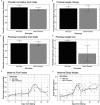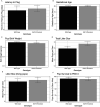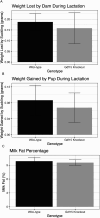This is a preprint.
GDF15 knockout does not substantially impact perinatal body weight or neonatal outcomes in mice
- PMID: 38746399
- PMCID: PMC11092610
- DOI: 10.1101/2024.04.30.591359
GDF15 knockout does not substantially impact perinatal body weight or neonatal outcomes in mice
Update in
-
GDF15 Knockout Does Not Substantially Impact Perinatal Body Weight or Neonatal Outcomes in Mice.Endocrinology. 2024 Oct 30;165(12):bqae143. doi: 10.1210/endocr/bqae143. Endocrinology. 2024. PMID: 39445824
Abstract
Growth differentiation factor-15 (GDF15) increases in circulation during pregnancy and has been implicated in food intake, weight loss, complications of pregnancy, and metabolic illness. We used a Gdf15 knockout mouse model (Gdf15-/- ) to assess the role of GDF15 in body weight regulation and food intake during pregnancy. We found that Gdf15-/- dams consumed a similar amount of food and gained comparable weight during the course of pregnancy compared to Gdf15+/+ dams. Insulin sensitivity on gestational day 16.5 was also similar between genotypes. In the postnatal period, litter size, and survival rates were similar between genotypes. There was a modest reduction in birth weight of Gdf15-/- pups, but this difference was no longer evident postnatal day 3.5 to 14.5. We observed no detectable differences in milk volume production or milk fat percentage. These data suggest that GDF15 is dispensable for changes in food intake, and body weight as well as insulin sensitivity during pregnancy in a mouse model.
Keywords: GDF15; pregnancy; stress; weight gain.
Figures







References
-
- Bootcov MR, Bauskin AR, Valenzuela SM, Moore AG, Bansal M, He XY, Zhang HP, Donnellan M, Mahler S, Pryor K, Walsh BJ, Nicholson RC, Fairlie WD, Por SB, Robbins JM, Breit SN. MIC-1, a novel macrophage inhibitory cytokine, is a divergent member of the TGF-β;superfamily. Proceedings of the National Academy of Sciences 1997;94(21):11514–11519. - PMC - PubMed
-
- Welsh P, Kimenai DM, Marioni RE, Hayward C, Campbell A, Porteous D, Mills NL, O’Rahilly S, Sattar N. Reference ranges for GDF-15, and risk factors associated with GDF-15, in a large general population cohort. Clinical Chemistry and Laboratory Medicine (CCLM) 2022. doi:10.1515/cclm-2022-0135. - DOI - PMC - PubMed
-
- Kempf T, Eden M, Strelau J, Naguib M, Willenbockel C, Tongers J, Heineke J, Kotlarz D, Xu J, Molkentin JD, Niessen HW, Drexler H, Wollert KC. The transforming growth factor-beta superfamily member growth-differentiation factor-15 protects the heart from ischemia/reperfusion injury. Circ Res 2006;98(3):351–360. - PubMed
-
- Suriben R, Chen M, Higbee J, Oeffinger J, Ventura R, Li B, Mondal K, Gao Z, Ayupova D, Taskar P, Li D, Starck SR, Chen H-IH, McEntee M, Katewa SD, Phung V, Wang M, Kekatpure A, Lakshminarasimhan D, White A, Olland A, Haldankar R, Solloway MJ, Hsu J-Y, Wang Y, Tang J, Lindhout DA, Allan BB. Antibody-mediated inhibition of GDF15-GFRAL activity reverses cancer cachexia in mice. Nat Med 2020;26(8):1264–1270. - PubMed
Publication types
Grants and funding
LinkOut - more resources
Full Text Sources
